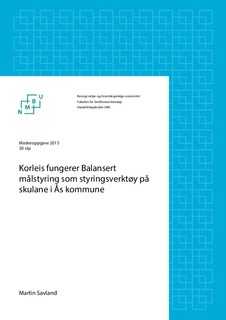| dc.description.abstract | Formålet med denne studien har vært å sjå om Ås kommune kan bruke BM på ein betre måte og eventuelt om man faktisk bør ha BM som styringsverktøy på skulane i kommunen. Oppgåva har derfor fokusert på skulane og korleis BM som styringsverktøy blir brukt og oppfatta som styringsverktøy for skulane i kommunen. Oppgåva har hatt som formål å auke kunnskapen i kommunen om BM og gje tilbakemeldingar til leiinggruppa, rektorarar og folkevalde i kommunen om korleis studien ser på BM utanfrå.
Studien bygger på stoff henta inn gjennom relevant teori og intervjuar med aktørar i kommunen som jobbar med BM. Oppgåva har brukt sekundærdata blant anna frå andre kommunar og undersøkingar gjort av avisar og rettleiingar frå Kommunal og Moderniseringsdepartementet. Oppgåva har vist at Ås kommune har verken for mange eller for få mål og at man er fornøgd med relevansen til måla. Samstundes har studien vist at det er usikker kor godt rektorane og folkevalde kjenner til systemet og usikkert kor mykje eigarskap det er til BM i kommunen.
Studien viser at Ås kommune er lite fornøgd med visjonen og at visjonen ikkje skaper noko stolthet over kommunen, men må forklaras for at folk skal forstå kva den inneheldt. Studia viste også at kommunens øvre visjon er lite tilpassa nedover til etaten oppvekst og kultur sin visjon og at desse to passar dårleg saman.
Studien gjekk inn på ulik teori man kan bruke når man ønskjer å finne ut korleis vi skal bruke BM og spesielt involveringstilnærminga som gjekk ut på at administrasjonen har ansvaret for å greie måla, mens politikarar sin rolle er å vedta dei. Dessutan gjekk oppgåva inn på eit alternativt som handlar i større grad om at folkevalte må involvere seg meir inn på å utgreie og sette måla og diskutere med dei tilsette på kva mål vi skal ha og korleis vi skal løyse måla.
Til slutt gjekk studien inn på at man i Ås kommune må drive meir opplæring og ikkje minst systematisk opplæring av dei tilsette om BM og i større grad jobbe for at dei tilsette og lokalpolitikarar føler eigarskap til BM om man ønskjer å bruke dette som styringsverktøyet i skulane. Dette understrekast gjennom analysane som viser at dokumenta er gode, men det manglar politisk og administrativt eigarskap til prosjektet. I Ås kommune har man balansert målstyring, men interessa for BM og resultata til BM er dessverre ganske lågt på grunn av lite eigarskap til BM. The purpose of this study was to see if Ås municipality could use Balanced Scorecard in a better way. This study have also seen if Balanced Scorecard is a good management tool for the schools in Ås.
This thesis have therefore focused on schools and how Balanced Scorecard, as a management tool, is used. The purpose has been to increase knowledge in the municipality about Balanced Scorecard and give feedback to leadership-groups, principals and local politicians in the municipality about my study and findings of the use of Balanced Scorecard in Ås.
The study has obtained data from theory and interviews with employees in Ås municipality who work with Balanced Scorecard. This study has also used secondary data from others municipalities, the Norwegian government and a newspaper that analyzed the use of Balanced Scorecard in Ås. The study showed that Ås did not have too many nor too few goals and that people are happy with the relevance of the goals.
On the other hand, this study has shown that the vision of Ås municipality is not quite good enough and does not give the inhabitants any pride. The vision should contain information as well as an explanation to understand the meaning in terms of how it works. This study has shown that the vision in the municipality and in the department of adolescence and culture are not compatible.
I have used different theory in this study to uncover how Balanced Scorecard works for Ås and particularly the involvement approach was used. This approach is about how the administration having the responsibility to set the goals and the politicians only to accepts the goals. This study shows that if the local politicians gets more involved in setting the right goals together with the employees, the goals would be better and easier to solve.
In the end, this study suggested that Ås municipality needs more training and systematic training of the employees regarding Balanced Scorecard and about how important it is to get employees and politicians to have ownership to the Balanced Scorecard system. If they do not change anything, it is likely that it will not turn out to work that well as a management tool in Ås. The documents are good enough, but still it is missing the ownership from both politicians and the administrations. In Ås municipality, they have Balanced Scorecard, but both the interest and the result of using the method is unfortunately quite low. The reason for this might very well be the small ownership by politicians and the administration. | nb_NO |
